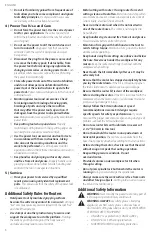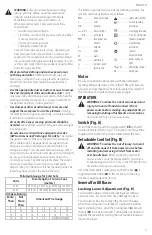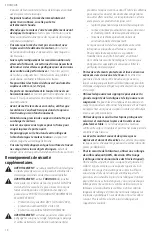
7
English
General for All Bases
Locking Lever Adjustment (Fig. E)
You should be able to clamp the locking lever without
excessive force. Excessive force may damage the base.
You should not be able to move the motor in the base
when the locking lever is clamped. To adjust the locking
lever’s clamping force, open the locking lever
4
and turn
the nut
24
in small increments. Turning the nut clockwise
tightens the lever while turning the nut counterclockwise
loosens the lever.
Detachable Cord Set (Fig. B)
WARNING: To reduce the risk of injury, turn unit
off and disconnect it from power source before
installing and removing cord set from motor
or D‑handle base.
Before connecting cord set to
power source, ensure the toggle switch (
10
and the
D‑handle trigger switch ( 13 are in the OFF position. An
accidental start‑up can cause injury.
Insert the detachable cordset plug so that the key
38
is
aligned with the notch
39
in the socket. Turn the plug
clockwise one quarter turn to lock.
Switch (Fig. A)
To turn the tool on, push the toggle switch
10
to the ON
position indicated on the tool. To turn the tool off, push the
toggle switch to the OFF position indicated on the tool.
OPERATION
WARNING: To reduce the risk of serious personal
injury, turn unit off and disconnect it from
power source before making any adjustments or
removing/installing attachments or accessories.
An accidental start‑up can cause injury.
Motor
Be sure your power supply agrees with the nameplate
marking. Voltage decrease of more than 10% will cause loss
of power and overheating. These tools are factory tested; if
this tool does not operate, check power supply.
The label on your tool may include the following symbols. The
symbols and their definitions are as follows:
BPM ....................beats per minute
V ......................... volts
min .....................minutes
j
or DC ............direct current
…/min ..............per minute
RPM .................... revolutions per
minute
A .........................amperes
Hz .......................hertz
W ........................watts
Wh ......................watt hours
no .......................no load speed
n .........................rated speed
c
.....................safety alert symbol
h
..................... wear respiratory
protection
f
..................... wear eye protection
i
..................... Class II Construction
(double insulated)
g
..................... wear hearing
protection
a
..................... read all
documentation
n
..................... avoid staring at
light
l
or AC............alternating current
Ah ....................... amp hours
WARNING:
Some dust created by power sanding,
sawing, grinding, drilling, and other construction
activities contains chemicals known to the State
of California to cause cancer, birth defects or
other reproductive harm. Some examples of these
chemicals are:
• lead from lead‑based paints,
• crystalline silica from bricks and cement and other
masonry products, and
• arsenic and chromium from
chemically‑treated lumber.
Your risk from these exposures varies, depending on
how often you do this type of work. To reduce your
exposure to these chemicals: work in a well ventilated
area, and work with approved safety equipment, such
as those dust masks that are specially designed to filter
out microscopic particles.
•
Wear protective clothing and wash exposed areas
with soap and water.
Allowing dust to get into your
mouth, eyes, or lay on the skin may promote absorption
of harmful chemicals. Direct particles away from face
and body.
•
Use the appropriate dust extractor vacuum to remove
the vast majority of static and airborne dust
. Failure
to remove static and airborne dust could contaminate the
working environment or pose an increased health risk to
the operator and those in close proximity.
•
Use clamps or other practical ways to secure and
support the workpiece to a stable platform.
Holding
the work by hand or against your body is unstable and may
lead to loss of control and injury.
•
Air vents often cover moving parts and should be
avoided.
Loose clothes, jewelry or long hair can be caught
in moving parts.
•
An extension cord must have adequate wire size
(AWG or American Wire Gauge) for safety.
The smaller
the gauge number of the wire, the greater the capacity
of the cable, that is, 16 gauge has more capacity than
18 gauge. An undersized cord will cause a drop in line
voltage resulting in loss of power and overheating. When
using more than one extension to make up the total length,
be sure each individual extension contains at least the
minimum wire size. The following table shows the correct
size to use depending on cord length and nameplate
ampere rating. If in doubt, use the next heavier gauge. The
lower the gauge number, the heavier the cord.
Minimum gauge for Cord sets
Volts
Total length of Cord in Feet
(meters)
120 V
25 (7.6)
50 (15.2) 100 (30.5) 150 (45.7)
240 V
50 (15.2) 100 (30.5) 200 (61.0) 300 (91.4)
Ampere Rating
American Wire gauge
More
Than
not
More
Than
0
6
18
16
16
14
6
10
18
16
14
12
10
12
16
16
14
12
12
16
14
12
Not Recommended










































